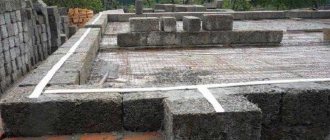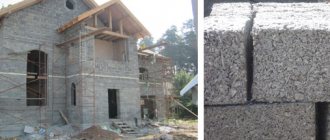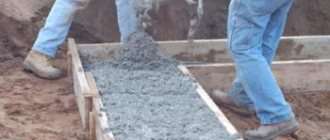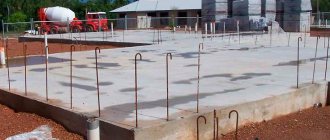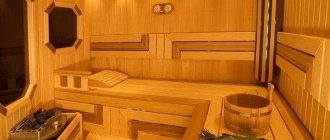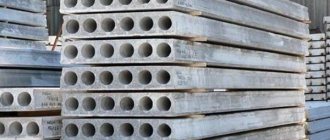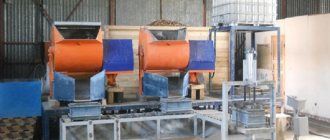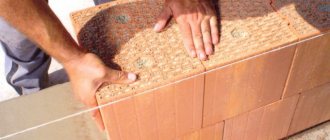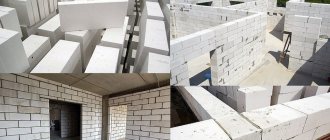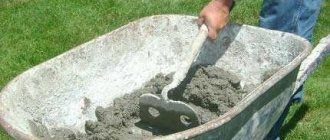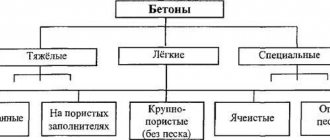| This article lacks links to sources of information. Information must be verifiable, otherwise it may be questioned and deleted. You may edit this article to include links to authoritative sources. This mark was set on October 26, 2020 . |
Arbolite block
Arbolite, close-up surface
Arbolite
(from the French arbre “tree”) - lightweight concrete based on cement binder, organic fillers (up to 80-90% of the volume) and chemical additives.
Also known as wood concrete
.
Wood concrete composition
Arbolite consists of:
- astringent. Portlandement M400 and M500, sulfate-resistant cement is also used, which increases the chemical resistance of the blocks
- filler is wood waste that is crushed, cleaned and processed using a special technique. Wood chips, veneer, tree bark, sawdust, flaxseed, cotton stalks, rice straw in the amount of up to 90% of the finished product give wood concrete many valuable and unique qualities, one of the main ones is its high heat-shielding properties.
- additives Plasticizers and hardening accelerators. Antiseptics and herbicides. Lime – as a bactericidal agent. Aluminum sulfate and sodium silicate - to break down sugars contained in wood and reduce hydrophilicity. Potassium and sodium liquid glass - for strengthening and preventing fermentation reactions. Corrosion inhibitors if metal reinforcement is intended. And that is not all.
A lot of chemicals and various additives are introduced into the wood concrete mixture, in different combinations. And there are also many recipes; to create blocks with a certain compressive strength, the selection of a composition with the exact amount of cement is calculated.
And with certain nuances - first of all, the sugars contained in the wood are neutralized, and then additives are introduced that close the pores so that the wood does not absorb water.
It is necessary to neutralize sugar; this is required by the chemistry of concrete. The binder does not react well with hydration, adhesion slows down, cement stone is formed too slowly and is not strong enough if processes occur in the presence of “sweet” molecules. Sugar is present only in fresh wood chips; if you keep it in the open air for up to six months, this sugar will decompose spontaneously, but waiting six months... is not always possible.
Advantages of wood concrete
The advantages of wood concrete are as follows:
- - high thermal insulation properties, as a result - increased energy efficiency of the building
- - excellent sound insulation
- — strength, excellent resistance to compression and bending, high crack resistance. Wood concrete does not chip in all directions, the material is completely isotropic
- - very light, the building does not require a strong foundation. This is with significant compressive strength and flexibility characteristics of wood concrete. For one-story, lightweight structures, masonry of walls made of wood concrete is carried out without inter-row reinforcement.
- - ease of processing. Blocks can be drilled, sawed, cut and grooved. And also make holes for utilities without any problems
- - resistant to erosion, corrosion, do not rot, do not form mold and plaque on the surface, especially when pre-treating wood fillers
- - high speed of laying compared to brick. Installation work is simplified due to its light weight, which saves labor and construction time
- - durability. They have been in operation for over 50 years.
- - fireproof
- - environmentally friendly. A house made of wood concrete “breathes”, it has a good microclimate, and the production of blocks does not harm the environment. Chemical additives introduced into the batch are safe.
Varieties
There are thermal insulation (density from 400 to 500 kg/m³) and structural (density from 500 to 850 kg/m³) varieties. It is usually used in the form of ready-made building blocks or slabs for the construction of self-supporting walls or internal partitions of buildings, as well as as a heat-insulating and sound-proofing material. Long-term operation of buildings and structures made from materials based on organic cellulose filler in various regions of our country, as well as in foreign countries, convincingly confirms the durability of Arbolit. Wall panels, blocks, slabs, and coverings for combined roofs are made from it. The technology of construction from monolithic wood concrete has become widespread. The advantages of this technology are the complete absence of masonry joints, and as a result, the absence of cold bridges, as well as the possibility of erecting walls of any thickness and architecture. This material is widely used abroad and is valued for its environmental and energy-saving qualities. In different countries, the analogue of “Arbolit” has its own name: “Durisol” - Holland and Sweden; "Woodstone" - USA and Canada; “saw concrete” - Czech Republic; "Centeri-boad" - Japan; "Duripanel" - Germany; "Velox" - Austria. This material is used in the construction of not only private houses, but also high-rise buildings for various industrial purposes.
Cons of wood concrete
We list the main disadvantages of wood concrete:
- When purchasing, it is difficult to check and select quality blocks. The market is flooded with handicrafts. Some manufacturers focus not on quality, but on PR and marketing gimmicks; unfortunately, this is our reality. And an arbolite block is very difficult to evaluate purely visually, without laboratory tests. You need to check certificates from suppliers, personally measure the geometry of the blocks, and avoid counterfeits. The popularity, ease and profitability of production, as well as the rare qualities of wood concrete... give this disadvantage.
- wood concrete in its natural form does not look very presentable... it looks like an adobe hut. And it needs a beautiful finish. In addition, wood concrete needs protection from the environment - rain and humidity. Not so long ago, blocks with spectacular and colorful finishes appeared, but their cost is still high.
- the cost of wood concrete is still higher than other lightweight concrete - gas and foam concrete. Although the wood concrete filler is natural and inexpensive, its processing requires an investment of time and money.
Notes
- GOST 19222-84 “Wood concrete and products made from it. General technical conditions". Document status as of 09/04/2018 - valid
- GOST R 54854-2011 “Lightweight concrete based on organic aggregates of plant origin. Technical conditions". Document status as of 09/04/2018 - valid
- SN 549-82 “Instructions for the design, manufacture and use of structures and products made of wood concrete.” Document status as of 09/04/2018 - valid
Wood concrete masonry technology
Some simple nuances and tricks of wood concrete masonry technology:
- external and load-bearing walls are laid out in one or one and a half blocks. The block sizes allow this. Self-supporting walls and partitions are usually made of blocks 20*25*50 cm, and external walls - 25*30*50 cm. The mortar is ordinary cement-sand, as for brickwork, lime can be added. The thickness of the seams should not be more than 15 mm.
- dressing and adjustment is carried out according to the type of brickwork, with offset rows, in order to avoid a decrease in strength and the appearance of cracks in the masonry. Just as with any masonry, it is necessary to check the horizon using a building level or a laser level.
- They begin to lay the walls from the corners, the mortar is applied both to the horizontal surface and to the end of the block. Water protection under the first row is mandatory.
- The wood concrete material is lightweight, so you will have to take breaks to dry the masonry. After about 3-4 rows, erected in one shift. This, of course, is a loss of working time. The time problem is partially solved by adding a hardening accelerator to the solution. You need to know that not all set accelerators have a beneficial effect on the strength of the mortar.
- about masonry reinforcement. Small lightweight buildings are not reinforced at all, since the compressive and bending strength of wood concrete is sufficient with a margin. But if the house has two floors, then it is necessary to reinforce the masonry with longitudinal rods at least in every fourth row. The diameter of the rods and rows are determined by calculation.
- the installation of reinforced belts under the mauerlat, as well as between floors and basements (if the foundation is not a slab, which is unlikely) for arbolite masonry is a severe necessity. The same as for all lightweight concrete. Although the strength of wood concrete makes it possible to install a roof of any type and type of covering, without restrictions. All you need is an armored belt to compensate for point stresses from the rafter system.
- cladding and protection from rain and direct sun are necessary for long service life of wood concrete without reducing its qualities. In addition, the roof overhang must be at least 35-50 cm.
- cutoff from capillary moisture, or in other words, horizontal waterproofing of the foundation surface under the first arbolite row is strictly required. Bitumen and bituminous mastics are used.
- wood concrete has very low thermal conductivity, and thermal breaks from joints are partially compensated, but the seams still give cold “bridges.” Laying dried wooden slats or polystyrene foam strips into the inner void will prevent heat loss.
- and another plus. Wood concrete practically does not shrink; experts call the figure 0.4% linear shrinkage, which is very little. You can carry out interior and exterior finishing with cladding immediately after finishing the masonry.
All building materials have shortcomings, and wood concrete is no exception, and it is still far from being finally tested by time for safe operation. And this material is not so cheap and easy to work with. But its special, unique properties have already attracted the attention of builders, and the massive use of building materials based on natural raw materials is only a matter of time.
Building a house is one of the main responsibilities of a man (after that, planting a tree and giving birth to a child). Everyone dreams of living in their own home. But, for this you will have to make a lot of effort, spend a certain amount of money and time, especially if you carry out the construction work yourself. Another problem is the choice of material for construction. At the moment, there are so many raw materials for work that you can break your head. You have to choose by analyzing the pros and cons of the material, the purpose of constructing the building, climate, available funds, etc. As practice has shown, one of the best materials for building a residential building is wood concrete. This is a practical, lightweight, durable, durable and environmentally friendly material, which is made from sawdust and Portland cement. Houses made of wood concrete blocks are distinguished by their energy intensity, because the heat conductivity of wood concrete is 0.07-0.16, depending on the density. Living in such a house is warm and cozy.
In this article we will look at how to build a house from arbolite blocks, the stages of doing the work yourself and some recommendations for constructing a foundation and laying walls. The article contains supporting videos.
Story
It is officially believed that wood concrete was invented by the Dutch in the 30s of the last century. Arbolite came to our country in the 1960s. The development of GOST for production was copied from the foreign model DURISOL (DURISOL). The material and technology DURISOL was developed in Holland and has gained wide popularity in Europe, Canada and the USA due to its environmental friendliness, simplicity and cost-effectiveness of construction due to high heat and sound insulation properties, good vapor permeability and low density of the finished wall structure.
"Arbolit", a domestic analogue of DURISOL, was developed in the 60s of the last century and passed all technical tests, and was also standardized and certified by the USSR, where more than 100 arbolite factories were built. The unique characteristics of wood concrete made it possible to use it for the construction of buildings even in Antarctica. In the early 60s, at the Molodezhnaya station, three service buildings and a canteen were built from arbolite panels. At the same time, the thickness of the arbolite walls was only 30 cm in harsh climate conditions. In large-scale housing construction until the mid-90s, it did not receive widespread use due to the focus on the construction of large-scale concrete block houses and its high energy-saving, heat-saving, and sound-absorbing properties were not taken into account. However, in the 90s, some factories that produced this material were collapsed, others were repurposed, and the industry for the production of composite buildings was destroyed. But buildings built from wood concrete more than 60 years ago are still in good condition today, which has shown its reliability and durability, high hygienic and operational properties.
Tools for getting the job done
You cannot complete the construction of a house without the right tools and materials. They must be prepared in advance and be in good condition. The list is as follows:
- shovel, stone-cutting saw.
- level, tape measure, plumb line;
- stakes and long rope;
- reinforcement bars Ø14 mm;
- solution container;
- trowel, notched trowel or trowel for laying blocks;
- rubber mallet;
- fishing line for leveling blocks.
Now you can start building a house from wood concrete blocks.
